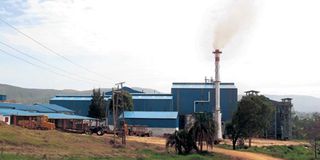Regulator moves in to end cane millers’ wars

The Butali Sugar Mills where farmers from Kakamega County deliver their sugarcane. FILE PHOTO | ISAAC WALE |
What you need to know:
- The bone of contention is the 10 kilometre distance between the two millers.
- The cane zoning formula in sugar belts maps out territories within which each miller is expected to develop their raw materials.
The battle for control of part of the western Kenya sugar cane belt by two rival millers has yet again exposed the deep-rooted challenges facing the sugar industry.
At the centre of the row are two privately owned millers — West Kenya Sugar Company and Butali Sugar Company — located 10 kilometres apart in the heart of Kakamega County.
While the Court of Appeal ordered a fresh licensing procedure for Butali Sugar Company after it emerged it was unprocedurally done, West Kenya holds the view that Butali ought to close shop altogether.
The bone of contention is the 10 kilometre distance between the two millers which, according to procedure, should be at least 40 kilometres but industry players are now accusing West Kenya of pursuing a monopolistic agenda.
The newly-formed Agriculture, Fisheries and Food Authority has literally been thrown into the deep end of an industry whose main conflict has always been occasioned by the desire to control supply of raw materials.
TERMED MEETING ILLEGAL
In its ruling two weeks ago, the Court of Appeal sitting in Kisumu ordered the Kenya Sugar Board, now a directorate under the food authority, to hear and determine afresh an application for a licence by Butali.
West Kenya, however, declined to attend a stakeholders meeting held on Monday with the aim of solving the impasse. It termed the meeting illegal, further deepening the conflict.
“I am new in the business but the problems in the sugar industry are proving to be historic and we have to handle them,” food authority acting boss Alfred Busolo said in an interview.
Mr Busolo observed that both millers apparently want exclusive zones within which to grow cane to guarantee them steady supply of cane.
“We have to delicately balance whether to grant operational zones or allow for contracting of farmers by millers,” Mr Busolo said.
The cane zoning formula in sugar belts maps out territories within which each miller is expected to develop their raw materials and work with farmers without encroachment from another operator.
The Kenya Sugar Board has, however, in the past criticised the model on grounds that it restricts farmers to a specific miller where they hive off territories and claim ownership and control at the expense of competition.
Mr Busolo cautions that feuds such as the one between Butali and West Kenya are a big threat to an industry reeling from high running costs and illegal cheap sugar imports.
CANE DEVELOPMENT PLAN
“The competition has to be checked because it could destabilise our sugar industry,” he said, adding that the distance between the two millers should not be a concern.
In the Nyanza Sugar belt, for instance, state-owned Muhoroni Sugar and Chemilil Sugar companies are less than 25 kilometers apart but have coexisted since the late 1960s.
Both firms, however, own nucleus estates — Chemilil 5,622 acres and Muhoroni 3,953 acres — which may explain the healthy coexistence between them as each is guaranteed cane supply.
“What we are witnessing between Butali and West Kenya is a product of Kenya Sugar Board licensing millers without a clear cane development plan,” Kenya Union of Sugarcane Plantation and Allied Workers boss Francis Wangara said in an interview.
Mr Wangara holds that according to the law, firms wishing to start milling are required to have sugar cane to be granted a milling licence.
“It is not a matter of the distance between the two millers… the truth is the court ruling gave West Kenya an opportunity to claim a large space for expansion,” he said.
The battle between Butali and West Kenya thus exposes a weakness in the licensing by Kenya Sugar Board which has left most millers barely struggling to protect their cane sources.
VIABILITY STUDIES
In defence, Kenya Sugar Board has always held that it studies the viability of each zone to sustain cane production before granting licences as opposed to granting licensing based on evident raw material supply.
Interestingly, the board last year denied Mumias Sugar Company a licence to put up another plant in Busia, despite the company controlling a huge chunk of farmers in the area.
It argued that the potential of the area had been exhaustively allocated to earlier applicants in mid-2012.
Kenya Sugar Board had registered three companies which are Busia, West Kenya (another subsidiary of the Kakamega-based West Kenya) and Mundika sugar factories.
West Kenya Sugar is not new to controversy. For the better part of 2010-2012, the company was locked in a feud with the listed miller Mumias over allegations of stealing raw materials.
The Kakamega-based miller was widely accused of offering contracted farmers higher pay per tonne of cane to lure them into reneging on contractual agreements.
The conflict pulled in Bungoma-based Nzoia sugar which also accused West Kenya of encroaching on its contracted farmers through what has come to be known as cane poaching.
The Agriculture Food and Fish Authority thus has a monumental task of bringing sanity to an industry that has been barely surviving due to protectionist measures granted by Comesa.
“Ours is to see a thriving industry by controlling all the challenges facing the sector,” the authority boss said.





